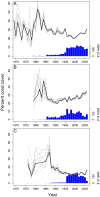A global analysis of the effectiveness of marine protected areas in preventing coral loss
- PMID: 20174644
- PMCID: PMC2822846
- DOI: 10.1371/journal.pone.0009278
A global analysis of the effectiveness of marine protected areas in preventing coral loss
Abstract
Background: A variety of human activities have led to the recent global decline of reef-building corals. The ecological, social, and economic value of coral reefs has made them an international conservation priority. The success of Marine Protected Areas (MPAs) in restoring fish populations has led to optimism that they could also benefit corals by indirectly reducing threats like overfishing, which cause coral degradation and mortality. However, the general efficacy of MPAs in increasing coral reef resilience has never been tested.
Methodology/principal findings: We compiled a global database of 8534 live coral cover surveys from 1969-2006 to compare annual changes in coral cover inside 310 MPAs to unprotected areas. We found that on average, coral cover within MPAs remained constant, while coral cover on unprotected reefs declined. Although the short-term differences between unprotected and protected reefs are modest, they could be significant over the long-term if the effects are temporally consistent. Our results also suggest that older MPAs were generally more effective in preventing coral loss. Initially, coral cover continued to decrease after MPA establishment. Several years later, however, rates of coral cover decline slowed and then stabilized so that further losses stopped.
Conclusions/significance: These findings suggest that MPAs can be a useful tool not only for fisheries management, but also for maintaining coral cover. Furthermore, the benefits of MPAs appear to increase with the number of years since MPA establishment. Given the time needed to maximize MPA benefits, there should be increased emphasis on implementing new MPAs and strengthening the enforcement of existing MPAs.
Conflict of interest statement
Figures




Similar articles
-
Small Marine Protected Areas in Fiji Provide Refuge for Reef Fish Assemblages, Feeding Groups, and Corals.PLoS One. 2017 Jan 25;12(1):e0170638. doi: 10.1371/journal.pone.0170638. eCollection 2017. PLoS One. 2017. PMID: 28122006 Free PMC article.
-
Functionally diverse reef-fish communities ameliorate coral disease.Proc Natl Acad Sci U S A. 2009 Oct 6;106(40):17067-70. doi: 10.1073/pnas.0900365106. Epub 2009 Sep 28. Proc Natl Acad Sci U S A. 2009. PMID: 19805081 Free PMC article.
-
Lag effects in the impacts of mass coral bleaching on coral reef fish, fisheries, and ecosystems.Conserv Biol. 2007 Oct;21(5):1291-300. doi: 10.1111/j.1523-1739.2007.00754.x. Conserv Biol. 2007. PMID: 17883494
-
Climate Change, Coral Loss, and the Curious Case of the Parrotfish Paradigm: Why Don't Marine Protected Areas Improve Reef Resilience?Ann Rev Mar Sci. 2019 Jan 3;11:307-334. doi: 10.1146/annurev-marine-010318-095300. Ann Rev Mar Sci. 2019. PMID: 30606097 Review.
-
Coral reefs: threats and conservation in an era of global change.Ann N Y Acad Sci. 2009 Apr;1162:136-86. doi: 10.1111/j.1749-6632.2009.04493.x. Ann N Y Acad Sci. 2009. PMID: 19432648 Review.
Cited by
-
Seascape genomics as a new tool to empower coral reef conservation strategies: An example on north-western Pacific Acropora digitifera.Evol Appl. 2020 Mar 19;13(8):1923-1938. doi: 10.1111/eva.12944. eCollection 2020 Sep. Evol Appl. 2020. PMID: 32908595 Free PMC article.
-
Rapidly increasing macroalgal cover not related to herbivorous fishes on Mesoamerican reefs.PeerJ. 2016 May 31;4:e2084. doi: 10.7717/peerj.2084. eCollection 2016. PeerJ. 2016. PMID: 27280075 Free PMC article.
-
Loss of Coral Trait Diversity and Impacts on Reef Fish Assemblages on Recovering Reefs.Ecol Evol. 2024 Oct 30;14(11):e70510. doi: 10.1002/ece3.70510. eCollection 2024 Nov. Ecol Evol. 2024. PMID: 39493612 Free PMC article.
-
Species distribution models of tropical deep-sea snappers.PLoS One. 2015 Jun 1;10(6):e0127395. doi: 10.1371/journal.pone.0127395. eCollection 2015. PLoS One. 2015. PMID: 26030067 Free PMC article.
-
Consumer diversity interacts with prey defenses to drive ecosystem function.Ecology. 2013 Jun;94(6):1347-58. doi: 10.1890/12-0389.1. Ecology. 2013. PMID: 23923498 Free PMC article.
References
-
- Sebens KP. Biodiversity of coral-reefs - what are we losing and why. American Zoologist. 1994;34:115–133.
-
- Hughes TP, Baird AH, Bellwood DR, Card M, Connolly SR, et al. Climate change, human impacts, and the resilience of coral reefs. Science. 2003;301:929–933. - PubMed
-
- Bellwood DR, Hughes TP, Folke C, Nystrom M. Confronting the coral reef crisis. Nature. 2004;429:827–833. - PubMed
-
- Halpern BS. The impact of marine reserves: do reserves work and does reserve size matter? Ecological Applications. 2003;13:S117–S137.
-
- Mumby PJ, Dahlgren CP, Harborne AR, Kappel CV, Micheli F, et al. Fishing, trophic cascades, and the process of grazing on coral reefs. Science. 2006;311:98–101. - PubMed
Publication types
MeSH terms
LinkOut - more resources
Full Text Sources

